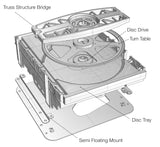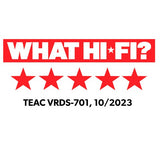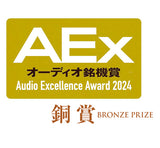TEAC VRDS-701
BRAND NEW - 12 MONTHS WARRANTY
TAKE AN ADDITIONAL 2% OFF THE PRICE IF PAYING BY CASH / BANK DEPOSIT
This is parallel imported European stock that is fully compatible with Australian 240V power. An Australian power cable and tax invoice receipt will be provided.
There is an average lead time of 2-3 weeks for this product. We don't hold stock of this model, it is always ordered on demand from our suppliers. A more accurate dispatch time estimate will be provided upon purchase, otherwise please contact us prior to purchase.
FREE delivery or local pickup by appointment at Carlingford NSW.
WHY SHOP WITH US?
- Exceptionally high rating by our customers on Google Reviews, eBay and productreview.com.au
- Every purchase will support a charity of your choice (or our default charity) and make this world a better place. Please see our Philanthropy page.
- Warranty provided by Electronic Forefront Australia Pty Ltd (ABN: 84 618 813 488) of any manufacturer defects. Within 30 days, a replacement/refund will be offered. After 30 days, a repair/replacement/refund will be offered depending on the nature of the defect.
========
Commemorating the 70th anniversary of our founding, this model brings innovation and epitomizes TEAC strengths, including a newly-developed VRDS mechanism.
The VRDS-701 CD player employs a newly-developed VRDS mechanism and a TEAC original discrete DAC. The VRDS is a TEAC-original CD drive mechanism that reduces rotation vibration and other unwanted vibration by clamping the CD to an aluminum turntable with the same diameter in order to maximize inertial mass.
Furthermore, instead of an ordinary DAC IC for the DAC section, which is crucial to audio quality, the VRDS-701 has a TEAC ΔΣ (delta-sigma) discrete DAC that incorporates our unique algorithms in a discrete circuit.
Unconstrained by conventional CD player definitions, the VRDS-701 is enhanced with future-forward functionality. The ability to play MQA CDs using full MQA decoding capabilities and support for 22.5MHz DSD and 384kHz/32-bit PCM formats as a USB DAC are some of the features that make it more than just a CD player.
Features at a glance
- A newly developed VRDS mechanism is used for the CD drive
- An original TEAC-designed discrete DAC is used for the digital audio converter, which is key to determining audio quality
- Fully-balanced dual mono circuit structure realizes outstanding channel separation
- Direct connection with a power amplifier is possible thanks to volume control that uses a TEAC-QVCS analog preamp circuit
- Along with MQA CD playback, full MQA decoding of digital input is possible
- As a USB DAC, 22.5MHz DSD and 384kHz/32-bit PCM data can be played back
- 2×, 4× and 8× upconversion using RDOT-NEO
- 10MHz external clock input
- Analog, digital input/output and CD drive circuits each have dedicated toroidal core transformers
- Original TEAC-HCLD2 enhanced-current output buffer circuit
- Headphone amp has a high output circuit with low distortion, high signal-to-noise ratio and a high 2000V/μs through rate
Vibration-Free Rigid Disc-Clamping System (VRDS)
This TEAC-original CD drive mechanism reduces rotation vibration of the disc itself as well as unwanted mechanism vibration by clamping the CD to an aluminum turntable with the same diameter and maximizing inertial mass in order to stabilize rotation. Servo current is reduced with the turntable by correcting disc warping and distortion and improving the relative optical axis precision of the pickup and disc pit side. This realizes reduced disc reading errors and outstanding audio quality.
Bridge section supports the VRDS
For the bridge that supports the turntable, we carefully selected lightweight materials that are very rigid and do not transmit vibration. By naturally settling vibrations quickly, we have realized a wide, dynamic sound. The bridge, which has a torus structure made of resin, is only fixed on one side, and propagation of vibration from the CD mechanism to the opposite side through the bridge is suppressed, so the entire mechanism minimizes unwanted sympathetic vibrations.
Semi-floating mounting
The entire CD mechanism is mounted on the sub-chassis in a semi-floating state. By controlling the transmission of vibrations between the CD mechanism and the chassis, the impact of sympathetic vibrations is abated, and natural playback sound is realized throughout the frequency range. By isolating motor vibrations from the main chassis, sympathetic vibrations within the chassis are prevented. At the same time, the CD mechanism is also isolated from external vibrations. Reading precision is also increased by isolating the CD mechanism from external vibrations.
TEAC ɅƩ delta-sigma discrete DAC
Instead of an ordinary DAC IC, the DAC section, which is critical for determining the sound, is a TEAC ΔΣ (Delta Sigma) discrete DAC that consists of a discrete circuit structure that incorporates our unique algorithms using FPGA. DSD signals are left as is, while PCM signals are converted to either 1-bit or multi-bit signals, according to the end users choosing, using a ΔΣ modulator and then output as high-quality analog signals. The sound field that is wide and perfectly clear can be realized only because of this discrete design. The result is that we can say we have achieved the sound sought by TEAC. With a TEAC ΔΣ discrete DAC, playback of 22.5MHz DSD and 384kHz/32-bit PCM data is possible.
Dual mono structure
Using independent left and right toroidal core transformers, we have employed an indulgent dual mono structure for the circuitry from the power supply circuit through the D/A converter section to the analog output stage.
The dual mono structure has two sets of circuitry that provide complete mono paths for each channel. This prevents interference between the left and right signals and realizes rich musical expression that emphasizes perception of the sound space and three dimensionality.
Fully-balanced transmission at every stage
Fully-balanced transmission of the left and right analog output signals from D/A conversion to the final output stage contributes greatly to improving the signal-to-noise ratio and extending the dynamic range. The sense of air that high-resolution audio sources have can be transmitted without loss in an even purer state.
Direct connection is possible with power amplifiers that use TEAC-QVCS
TEAC-QVCSThis player can be directly connected to a power amp and used without a preamp due to the inclusion of TEAC-QVCS, which is an analog variable gain amp type attenuator with a fully-balanced structure.
TEAC-QVCS (Quad Volume Control System) is a variable gain amp type volume control comprised of four discrete left, right, positive and negative (L+, L–, R+ and R–) circuits. This theoretically prevents "gang errors" (level discrepancies between left and right channels at low volumes) and enables extremely precise analog volume adjustment in 0.5dB increments from–95 dB to +24 dB.
The two sets of analog outputs (balanced/unbalanced) can be set to fixed or variable output.
Inclusion of an MQA full decoder enables MQA CD playback
MQA (Master Quality Authenticated) is a high-quality audio codec for playing music with the uncompromised quality of the master captured in the studio. The VRDS-701 includes an MQA decoder that controls waveforms converted from digital to analog at a precision as high as 5ms in order to achieve analog waveforms that are more faithful to the original sound sources. By greatly reducing “temporal blur,” which tends to occur at points when sound pressure differences are extreme, including when sounds begin suddenly, playback sound that is close to the original source in terms of human hearing can be achieved.
The inclusion of an MQA full-decoder not only enables enjoyment of MQA CDs, it also makes decoding of MQA data from the digital inputs possible, allowing playback of MQA files from a computer when used as a USB DAC.
As a USB DAC, 22.5MHz DSD andr 384kHz/32-bit PCM data can be played back
A USB Type-C port is available for digital input. The VRDS-701 is much more than a CD player. Connected to a computer with USB, it can be used as a USB DAC, enabling enjoyment of the computer audio world with high-resolution audio sources.
2×, 4× and 8× upconversion using RDOT-NEO
RDOT-NEO (Refined Digital Output Technology NEO), which smoothly augments digital audio signals, provides a function to upconvert the sampling frequency of PCM digital signals 2×, 4× or 8× (up to 384 kHz). RDOT, which applies an analogous interpolation method using fluency logic, is a technology that was developed to enable the playback of the frequencies higher than 20 kHz that are lost by the 44.1kHz/16-bit CD format. Based on the information read from the CD, analogous data is generated between the waveform samples. As a result, data above 20 kHz is also generated.
10MHz external clock input
The 10MHz clock input allows synchronization with an external clock. In addition to improving audio quality during playback with the VRDS-701, this also enables synchronization of the entire system with a clock generator.
High-precision dual clock for 44.1kHz and 48kHz multiples with low phase noise
This player has low-phase-noise type high-precision crystal oscillators. Along with 44.1kHz for CD playback, it supports 48kHz clock, which is necessary for playing files from a computer when used as a USB DAC.
Power supply enhanced by three high-capacity toroidal core transformers
In addition to a toroidal core transformer for the analog signals, the digital control section and the CD mechanism each have independent high-capacity toroidal core transformers. Through the supply of steady current using these three toroidal core transformers, the sudden starts and stops of sounds can be expressed clearly, realizing outstanding sound linearity. The transformers are each mounted to the sub-chassis, controlling vibrations.
TEAC-HCLD2 enhanced-current output buffer amp circuit
For the analog output circuit, the TEAC-HCLD 2 circuit is an enhanced-current output buffer amp that increases crucial current transmission capability. This model uses diamond buffer amps with high current output capacity as line drivers. By using a positive-negative two-circuit structure for each channel, drive can be differential with balanced output and parallel with unbalanced output. Transmitting audio signals without degrading their dynamism becomes possible with increased current supply capacity.
Headphone amp
The headphone amp has a dedicated driver that uses a high-output circuit with low distortion, high signal-to-noise ratio and a high 2000V/μs through rate, equivalent to a current transmission enhancing output line driver. This will maximize the potential of your headphones.
Bulk Pet USB communication technology enables stable data transmission
When sending vast quantities of digital data for high-resolution audio sources through USB cables, large discrepancies can occur in the processing loads of both the transmitting computer and the receiving USB DAC. This creates the possibility of the sound breaking up and other problems. Using Bulk Pet USB transmission technology, however, achieves constant transmission at a fixed data volume, enabling steady data transmission by smoothing the loads for processing on both ends. Since the audio quality can be altered by changing the load on the computer, four preset transmission modes can be chosen according to the desired audio quality.
Thorough design for vibration control
Power transformers, which tend to generate vibration, are mounted on a floating structure, separating and isolating them from the bottom panel. The side fins for heat dissipation have been tailored so that each one has a different length in order to eliminate sympathetic vibrations.
Three supporting pinpoint feet made of machined steel with a unique structure
The circuit board attachment screws have been kept to a minimum. Furthermore, steel pinpoint feet that use an original TEAC design with a new structure to provide a suitable amount of play in the connection between them and the bottom panel, are employed to thoroughly control vibrations that could affect audio quality.
Control connectors enable coordinated use with other devices
RS-232C is present for integration with popular control systems, and trigger input and output connectors enable power coordination with other devices.
TEAC HR Audio Player provided free
High-resolution audio sources, up to 22.5MHz DSD or 384kHz/32-bit PCM, can be easily played from Windows and Macintosh computers using this free dedicated software. Digital audio data can be transmitted with certainty under the best conditions by simply starting the software and selecting the VRDS-701 that is connected using a USB cable.
Since the software is designed for use with this product, making USB audio settings is trouble-free.
SPECIFICATIONS
CD section
Supported media: Audio CD, CD (CD-R/CD-RW) * 8cm CDs not supported.
Frequencey response: 5Hz to 80kHz (+1dB, –6dB)
S/N ratio: 108dB (A-weight, 1kHz)
Total harmonic distortion: 0.002% (1kHz, LPF: 20Hz to 20kHz)
Analog audio outputs
Balanced
Connectors: XLR × 1 pair
Maximum output level:
- 2.0Vrms (1kHz, Full scale, 10kΩ loaded, FIXED 0dB)
- 4.0Vrms (1kHz, Full scale, 10kΩ loaded, FIXED +6dB)
- 12Vrms (1kHz, Full scale, 10kΩ loaded, VARIABLE)
Output impedance: 220Ω
Unbalanced
Connectors: RCA × 1 pair
Maximum output level:
- 2.0Vrms (1kHz, Full scale, 10kΩ loaded, FIXED 0dB)
- 4.0Vrms (1kHz, Full scale, 10kΩ loaded, FIXED +6dB)
- 6Vrms (1kHz, Full scale, 10kΩ loaded, VRIABLE)
Output impedance: 180Ω
Digital audio inputs
USB
Connector: USB Type-C × 1 (USB2.0 or more)
Supported formats:
PCM:
- 16 / 24 / 32bit
- 44.1k / 48k / 88.2k / 96k / 176.4k / 192k / 352.8k / 384kHz
DSD: 2.8M / 5.6M / 11.2M / 22.5MHz
COAXIAL
Connector: RCA × 1
Input level: 0.5Vp-p
Input impedance: 75Ω
Supported formats:
PCM:
- 16 / 24bit
- 32k / 44.1k / 48k / 88.2k / 96k / 176.4k / 192kHz
DSD: 2.8MHz
OPTICAL
Connector: TOS (JEITA RC5720C) × 1
Input level: –24.0 to –14.5dBm peak
Supported formats:
PCM:
- 16 / 24bit
- 32k / 44.1k / 48k / 88.2k / 96k / 176.4k / 192kHz
DSD: 2.8MHz
Digital audio outputs
COAXIAL
Connector: RCA × 1
Output level: 0.5Vp-p
Output impedance: 75Ω
OPTICAL
Connector: TOS (JEITA RC5720C) × 1
Headphones out
Connector: ¼″ (6.3mm) Stereo jack × 1
Maximum output: 500mW + 500mW (into 32Ω)
Clock sync input
Connector: BNC × 1
Input frequency: 10MHz
Input impedance: 50Ω
Input level:
Rectangle wave: Equivalent to TTL level
Sine wave: 0.5 to 1.0Vrms
External control
Trigger in (12V TRIGGER IN)
Connector: 3.5mm Mono mini jack × 1
Input level: 12V, 1mA
Trigger out (12V TRIGGER THRU)
Connector: 3.5mm Mono mini jack × 1
Output level: 12V
Maximum curret supply: 100mA
Power: AC220-240V, 50/60Hz
Power consumption: 20W
Standby power: 0.4W
Overall dimensions: 444 (W) × 111 (H) × 333 (D) mm (including protrusions)
Weight: 11.1kg
Operating temperature: +5 degrees C to +35 degrees C
Operating humidity: 5% to 85% (no condensation)
Storage Temperature range: −20℃ to +55℃
Included accessories: AC cord, Remote control (RC-1338), AAA batteries × 2, Foot pads × 3, Owner's manual



































